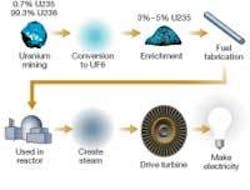LASER ISOTOPE SEPARATION: Fuel-enrichment method garners GE contract

A closely guarded technology developed in Australia for separation of isotopes by laser excitation (SILEX) appears to have cleared enough of the significant technological, economic, and political hurdles in the controversial field of nuclear-fuel enrichment to attract the attention and collaboration of the General Electric (GE) nuclear business (Wilmington, NC). In May, GE signed an exclusive agreement with Silex Systems (New South Wales, Australia) to license the technology and develop the company’s next-generation low-enriched-uranium manufacturing process in the United States.
Natural uranium contains 99.3% uranium-238 (U238). To increase the remaining 0.7% concentration of uranium-235 (U235) to that required of reactor fuel (2% to 3%), the isotopes must be separated (see figure). Nearly identical electronic and chemical properties of the two isotopes render chemical processing difficult and inefficient, however, so conventional separation methods rely on small differences in the masses of the different isotopes. For instance, the gaseous diffusion method of producing enriched uranium for nuclear reactors consists of passing gaseous uranium hexafluoride molecules (UF6) through a series of chambers separated by porous barriers.1
Laser-based isotope separation holds out the potential of becoming the third-generation uranium enrichment process, following first-generation gas diffusion and second-generation gas centrifuging-two mechanical technologies with relatively high cost. Laser isotope separation can be used for numerous materials, such as ytterbium, silicon, zirconium, and carbon, but the GE-Silex deal focuses on the global uranium-enrichment market, currently worth approximately $5 billion annually, according to Silex Systems. Silex Systems expects the growing market to increase over the medium term as the energy policies of many countries begin to respond to the threat of global climate change and to pursue sustainable energy policies.
IR-laser excitation
The SILEX process consists of a UF6 vaporization process, a separation system, and withdrawal system. The UF6 is mixed with a carrier gas, cooled to a low temperature and is fed to a separator system. The U235 component is selectively excited with a pulsed laser operating in the 16 µm IR spectral region. This results in a separation of the two isotopic forms into an enriched product and a U238-rich “tails” stream, both of which are mechanically removed into a collection system. The separator system is cascaded to enrich the U235 concentration.
The GE-Silex agreement provides for a phased approach to the commercialization of the SILEX technology. Steps include construction of a test loop, pilot plant, and a full-scale commercial enrichment facility. These operations would be built at GE’s existing nuclear-energy headquarters and technology site in Wilmington, NC, or another suitable location in the U.S. In addition to funding the technology-development program, GE has agreed to make a total of $55 million in payments to Silex Systems incrementally at key points in the processes of government approval, testing, and construction. GE has also agreed to pay royalties to Silex Systems up to a maximum of 12% upon deployment and use of the technology.
While the deal focuses on nuclear enrichment for peaceful purposes, relatively recent reports published by Greenpeace Australia Pacific and by the Bulletin of Atomic Scientists warn of the potential of SILEX for significantly lowering logistical barriers to the international proliferation of nuclear weapons.2, 3 In 1996, after Silex Systems signed an agreement with the United States Enrichment Corp. (USEC), the U.S. Department of Energy (DOE) classified the SILEX process as “restricted data,” a classification that usually relates to the design of nuclear weapons or the use or acquisition of nuclear material suitable for their construction, according to the Greenpeace report. “This was the first time in history that privately held technology was given this classification,” said the report. “The deal with USEC required the drafting of a new bilateral agreement between Australia and the U.S. because existing agreements specifically banned the transfer of weapons-related technology.”
REFERENCES
1. R.J. Jensen et al., Los Alamos Science 3(1) 2 (Winter/Spring 1982).
2. J. Boureston, C.D. Ferguson, Bulletin of the Atomic Scientists 61(2) 14 (March/April 2005).
Hassaun A. Jones-Bey | Senior Editor and Freelance Writer
Hassaun A. Jones-Bey was a senior editor and then freelance writer for Laser Focus World.